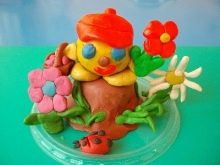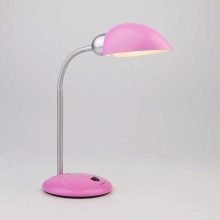How to make a Kolobok from plasticine?

Modeling perfectly develops the child's motor skills, therefore, it is recommended to make a Kolobok from plasticine only with his direct participation. The process of recreating this fairy tale will be especially interesting for children from 4 to 8 years old. The instructions and rules for sculpting will help make the process pleasant and fun, and the resulting character will be as realistic as possible.



Basic sculpting rules
The work should be carried out in stages, the lesson itself should not be fleeting - the baby should do as much as possible with his own hands. An adult only needs to knead hard pieces of plasticine at the very beginning, but in general, the process of making a fairy-tale character is not difficult. The main thing is to properly prepare the workplace, tools and materials, as well as adhere to the basic rules of sculpting.
- It is imperative to sculpt a kolobok with a child on a special board, having previously covered the tabletop with newspaper or stretch film. Plasticine, especially of domestic production, strongly "sticks" into the wooden surface of home desks. Sometimes, in order to remove it, you have to use various chemicals that corrode and spoil the surface.
- It will not be superfluous to cover the floor near the table, since accidentally dropped small pieces of plasticine can eat into the carpet or carpet.
- You should take care of the light source: the surfaces of the board and table should be well lit, it is best to work under a table lamp or in daylight when the table is near a window.
- In the process of sculpting, you need to ensure that the child does not rub his face and eyes with his hands stained with plasticine.Depending on the brand and manufacturer, the material may contain various synthetic additives that can irritate the eyes.
In case of accidental contact, rinse eyes and face thoroughly with running water.



Before you start sculpting, it is better to make rough sketches of the future product, because there are no exact instructions for execution here. Kolobok can be decorated according to your personal preferences, as well as remove or add props - hemp, trees, other characters.
Before work, plasticine should be well warmed up, thoroughly kneading it in the palms of your hands. When sculpting small elements, it makes no sense to heat up the entire "brick" of the material; you can cut off the desired piece with a knife, having moistened the blade with warm water beforehand. When heating plasticine, the main thing is not to overdo it, otherwise the material will become too soft and stubborn.


What is necessary?
To sculpt a fabulous Kolobok from plasticine, you will need the following tools and consumables:
- a set of colored children's plasticine;
- two boards for modeling;
- a plastic knife or a special stack (usually comes with the material);
- rags;
- warm water.



Instructions
A plasticine gingerbread man is not just a ball with eyes, but a whole set of individual elements that make up a fairy-tale character. Besides, in order to recreate the plot of a fairy tale as much as possible, you will also need additional props - a stump for Kolobok, a path, a bush or mushrooms. Very often, creating such a composition with a child, in addition to Kolobok, they also sculpt other accompanying characters - a wolf, a fox, a bear. Let's consider step by step how to mold a Gingerbread man from plasticine with your own hands with your baby.
Divide a standard block of children's yellow plasticine into two parts, knead and warm the piece with your fingers, and then, placing it between your palms, roll the ball in a circular motion. Pinch off two small pieces from a bar of white plasticine and roll two balls - the character's eyes.



Before landing on the main ball, make small indentations in it using a stack or a plastic knife. Fix the white balls in the recesses - the distance between them is chosen arbitrarily. At a short distance below the eyes, cut out a longitudinal groove with a stack - the mouth of the Kolobok. Make the lips of the character from the red material: after kneading a piece of plasticine of the required size, place it between the palms and with forward movements, roll two elongated rollers in turn.
To make the rollers look the same, it is recommended to trim them between two sculpting boards. The length and thickness of the element is chosen independently for your specific composition.



Having pinched off a piece of orange plasticine, roll up a ball a little larger than the eyes - Kolobok's nose. Place the element in the desired place, then stick the pre-prepared lips.
To make the lesson more interesting for the child, and the sculpture of the Kolobok turned out to be more beautiful, you should also make his arms and legs. To do this, you need to pinch off four pieces from the yellow block of plasticine and slightly roll them into small cakes, narrowed on one side. Then make the appropriate notches in them with a stack and attach them to the product.



The gingerbread man should be planted on a stump, for its production you will need two pieces of plasticine of different colors - white and black. Roll out two identical rollers from white and black material and press them with your fingers along the entire length to get oblong wide stripes. Then lay one strip on top of another, press firmly and roll a large roller out of the resulting workpiece. To keep the top cut of the hemp even, you can put the element in the refrigerator for a few minutes, and when it hardens, carefully cut off the top layer with a knife with a dampened blade.
Roll several short rollers out of white plasticine and, using a plastic stack, make a small incision at the end of each, bifurcating the tip - these will be hemp roots. Attach them to the main element and apply small oblong pieces of black material to the entire surface to make the stump more real, similar in this case to birch.



Additionally, decorate the stump with mushrooms - fix two or three white rollers on it (they should be short and wide), and on top of them set balls or "hats" made of red material. From above, the mushrooms can be decorated with dots so that they look like bright amanita - stick with pieces of white plasticine.
Fix the Kolobok on the stump. To make it "sit" stronger and not fall off the hemp when carrying the sculpture, it is better to fix it with a piece of wire or a thin wooden stick. You need to insert the rod into the center of the hemp, and already fix the character himself on it.



To learn how to mold a Kolobok from plasticine, see the next video.








